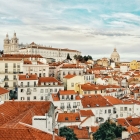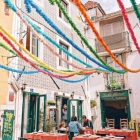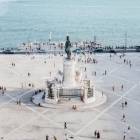Blog

3 MUSEUMS TO VISIT ON THE WEEKEND
One of the ways to get to know the city and its history is undoubtedly through its museums... And it’s always a good option at any time of the year, rain or shine. Today I share with you three museums that are worth knowing and that you can visit on the weekend as well.
Museu do Aljube

At 42 Rua Augusto Rosa, in the center of Lisbon, is the Museum of Aljube | Resistance and Freedom. Nationally, this is a unique museum, dedicated to remembering and documenting the fight against the Portuguese dictatorship.
The Aljube building, an Arabic word meaning waterless well, cistern, dungeon or prison, was a prison prior to being a museum. Firstly, an ecclesiastical prison, then a women’s prison until the late 1920s, and a political prison during Estado Novo (until its closure, in 1965).
This is not a casual visit, but it’s a necessary and important visit to get to know the recent history of the country, because, as we can read on one of the walls, “without memory there’s no future”.
Over 3 floors (ground 1, 2, and 3) there’s the Permanent Exhibition, where the building’s history is portrayed, as well as the rise and fall of fascism, the pillars of the Salazar regime, the censorship and the clandestine press, the anti-fascist resistance and its organization approaches, the identification processes of prisoners and the interrogation and torture means.
We can discover the documents censored by the political police (PIDE), the cells (the well-known “curros”), and the description of the torture methods used, as well as documentaries with testimonies of prisoners, photographs and newspapers of the time... And even a ringing phone that simulates the prisoners’ call to the police (that really got me scared when I walked in the hallway).
On level -1, we can see an archeological display lifted from the basement of the building. On level 0 are the museum’s reception and store, the temporary exhibitions, and the heritage history of the Aljube. The main gate of the old Cadeia do Aljube is now closed, although it’s kept as evidence from the former prison. The museum also has a Documentation Center and an educational service that organizes didactic visits.
The Aljube Museum can be visited from Tuesday to Sunday, from 10 a.m. to 6 p.m., free of charge every Sunday, and on public holidays until 2 p.m.
Teatro Romano - Museu de Lisboa

Between Rua de São Mamede and Rua da Saudade we can find Teatro Romano. It’s part of the core of Museum of Lisbon and consists of an exhibition area, an archaeological field and the ruins of the theater.
Here you can travel through centuries in the center of Lisbon. This was one of the most important monuments of Olisipo (Lisbon’s ancient name), was built on the hill of the Castelo de São Jorge during the roman occupation, and is now a museum installed in two buildings. Did you know that Lisbon is the only European capital (other than Rome) that has a Roman Theater?
The museum intends to raise awareness about the theater built at the time of Emperor Augustus, and rebuilt in 57 AC at the time of Nero. It was abandoned in the 4th century, and remained buried until 1798, when the ruins were discovered after the 1755 earthquake, when the caboucos(ditches) were opened for the construction of buildings under the general pombaline restoration project.
It wasn’t until the second half of the 20th century that the Roman theater was “discovered” again, becoming the target of several archaeological campaigns, along which part of the benches, the orchestra, the downstage, the stage, and a set of archaeological and decorative elements were recovered.
In the exhibition area we find iconographic elements and a very interesting Roman archaeological archive. Information on the history, function and architecture of the theater is complemented with multimedia support.
The visit to the ruins is free and the visit to the archaeological and exhibition camp costs €3 (normal ticket). It’s open from Tuesday to Sunday, from 10 p.m. to 6 p.m., and on Sundays and public holidays admission is free until 2 p.m. There’s also the possibility of conducting a guided tour by prior appointment.
MONEY MUSEUM

The Money Museum is located in the old Igreja de São Julião, and belongs to Banco de Portugal. It tells the story of money and other payment means, as well as its evolution over time, in Portugal and the world.
The visit begins right at the main door, which was once the door of the vault that was situated in the building’s underground, and kept the country’s gold reserves.
And what better way to start the tour tan to be able to touch a real gold bar? Here, a 24-karat gold bar is on display, with about 12 kg, and a 99% purity.
The visit is free and lasts approximately 90 minutes. The tour through the collection can be done autonomously from 10 a.m. to 6 p.m., from Wednesday to Saturday, or through a guided tour that takes place on Saturdays at 3 p.m.
This route includes nine thematic rooms, distributed in three floors, where we can see the reference pieces of the collection and know its historical content. The place also has several interactive experiences (for example, it’s possible to virtually mint a coin with our face, or throw coins into a wishing well). These virtual experiences are then accessible on the museum’s website, through the ticket number that’s assigned to each visitor - the kids will certainly love the surprise!
On the building’s level -1, you can also visit King Dinis Wall, which is also free and has guided tours on Saturdays at 11 a.m.
ABOUT SÓNIA JUSTO
 |
The blogger and founder of Lovely Lisbonner, a travel and gastronomy blog. She loves Lisbon, to stroll, to travel and to eat... And don’t ask her to be in the same place for too long because what she really likes is to go on a journey of discovery! She was born in Lisbon and lived much of her childhood in Alvalade, her favorite neighborhood in Lisbon, she now invites us to discover her favorite places of the city (and the world as well). |




 Download App
Download App














